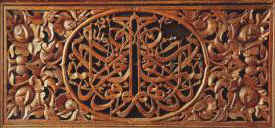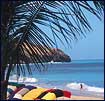| Relief wood carvings frequently adorn the doors, walls and windows of traditional Malay houses. Popular motifs of such relief carvings are the various kinds of Malaysian flowers and plants. Relief carvings requires a high degree of skill, patience and determination. In the cities, relief carvings is still practiced on blocks of wood to be hung for wall decoration, on wall dividers, or on furniture. The best Malay woodcarving is from Terengganu and Kelantan. Passed down from one generation to another, the craft is divided into ukiran halus (fine carving) and ukiran kasar (literally meaning “rough carving”) Ukiran Halus involves the carving of relief patterns, hilts of keris (short Malay dagger), bed heads and cupboard tops. Ukiran Kasar, refers to the carvings on larger objects like furniture, pillars, windows, room portions and eaves of roofs. The Design The basic design behind Malay woodcarving is the awan larat (‘extending clouds”). Its usage in a composition is governed by four principles. Firstly, the design element must be evenly distributed in the composition. Secondly, the empty spaces or uncarved areas should be the same as carved areas. Thirdly, animals or humans should never be depicted and fourthly, when there is a central motif, the other secondary design elements are to be repeated around it. Apart from the awan larat, other common inspirational elements include holy verses from the Qu’ran and plants such as bean tendrils, groung leaves, and leaves of the water lettuce. The Wood Cengal is the preferred wood for building houses and boats. Being expensive, other woods such as balau or perah (which is slightly softer than cengal) might be used for the rafters, or floorboards of a house or for the prow of a boat. Some types of wood such as Merbau and Rengas are avoided as the Merbau tree is believed to be the home of evil spirits while the Rengas contains a poisonous sap.
The Carving The carving process involves four stages. First, the design is traced and transferred to the object such as a panel. Then the outline of the design is chiseled. Thirdly, the unwanted parts are then cut out. The final and most intricate stage is the actual carving itself. This being accomplished using a myriad of carving tools to pare, chisel, shave, drill and dig to bring the design to life. The final carving is polished using emery paper now whereas the dried skin of the stingray or the leaf of a wild plant called mempelas was used before. |


